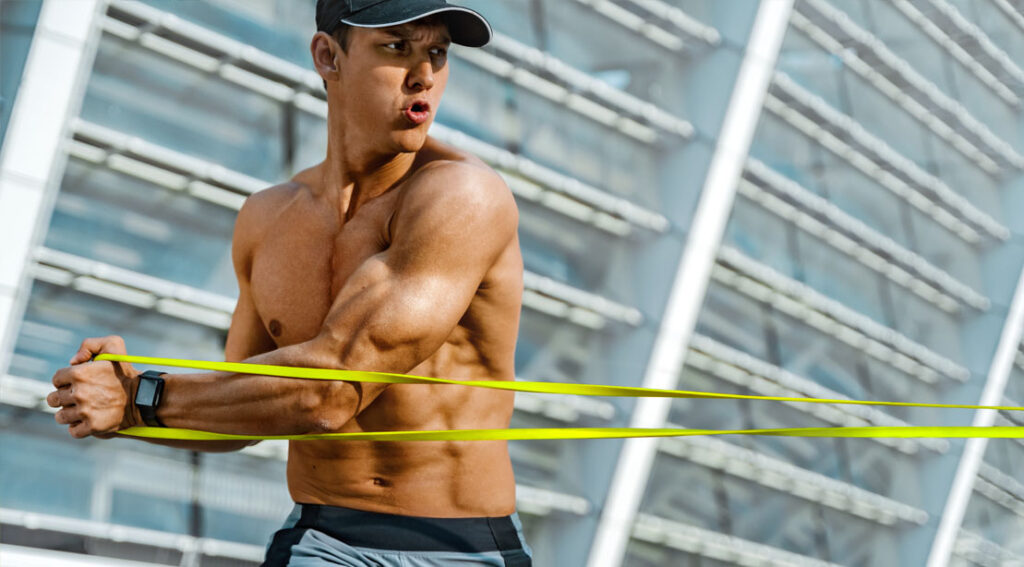[ad_1]
When it comes to building shoulder mass, overhead presses and lateral raises are the staple moves of many workout routines. Although these traditional exercises are excellent at building strength and creating the coveted ‘capped’ shoulders, banded shoulder rotations hold their own (and then some).
“Internal and external shoulder rotations are important for shoulder health because they help strengthen the rotator cuff, which stabilizes the shoulder joint,” explains Alicia Cruz, CPT, and bodybuilding athlete. “By strengthening these muscles, it helps reduce the risk of injury; Internal and external rotations also help improve range of motion and can help improve posture.”
Cruz provided a few banded shoulder rotation techniques to help you level up your shoulder health.
What Are Banded Shoulder Rotations?
Simply put, banded shoulder rotations are exercises that involve opening and closing your shoulder towards and away from your body using a resistance band.
The Difference Between Internal and External Rotations
External rotations turn the shoulder joint away from your body whereas internal rotations involve turning your shoulder towards your body.
Why Choose Bands for These Exercises?
Beyond convenience and versatility, “the biggest reason why bands are such a great choice is that when doing the exercise, your shoulder will be the primary muscle doing the work, as opposed to dumbbells. When you use dumbbells, the weight pulls downward and ends up working the biceps, which takes away focus from the shoulder,” explains Cruz.
Not only do bands help keep the focus on the muscle at hand, but make for a fantastic warmup on upper-body day.
Added Benefits of Banded Shoulder Rotations
- Reduces risk of shoulder injuries (rotator cuff)
- Improves training performance
- Strengthens key stabilizer muscles
- Increases joint stability
- Improves posture
Banded Internal and External Shoulder Rotations
Trainer’s Note: For the first three exercises, you’re going to have the band attached at waist height.
Try This: While performing rotations, place a rolled-up towel between your elbow and your body. The added padding and support can help reduce stress on your shoulder joints making this move even more safe and effective.
Beginner Tip: Start with light resistance, move slowly and with control, tighten your abdominals, and focus on mind and muscle connection.
External Banded Shoulder Rotation
- While standing with the band to your side, hold the end of the band/handle with your outside hand and a neutral grip (palm facing in). The band will be across your body in front. While keeping the outside arm bent at a 90-degree angle and pressed to your side throughout the whole movement, pull the band out and away from you (only your forearm will be moving out.)
- While keeping the same positioning and movement, simply switch your grip to a supinated grip (palm up), and repeat the same movement, keeping the arm pressed into your side and pulling out against the resistance.
Internal Banded Shoulder Rotation
- Similar to the first two movements, you will be standing sideways to the anchor with your arm bent at a 90-degree angle and pressed into your side. Now, you will be using your inside arm, holding the band with a neutral grip, and pulling the band across your body.
- Attach the band low to the floor. While lying on your side (you can be on the floor or up on a couch or bed), face the band and grab the band with your top hand, keeping your elbow in by your side. Repeat the same motion as exercises 1 and 2.
- While standing or seated, hold the band with a supinated grip, and while keeping your elbows pressed into your sides with your arms bent at a 90-degree angle, pull the band apart, spreading both hands away from each other.
Trainer Tips:
Cruz recommends performing rotations before your upper body days as a warm-up to help prevent injury.
For the first 4 exercises, the closer you are to the band’s anchor, the easier it will be, while the further away you are, the harder it will be, so choose your body placement accordingly.
[ad_2]
Source link


